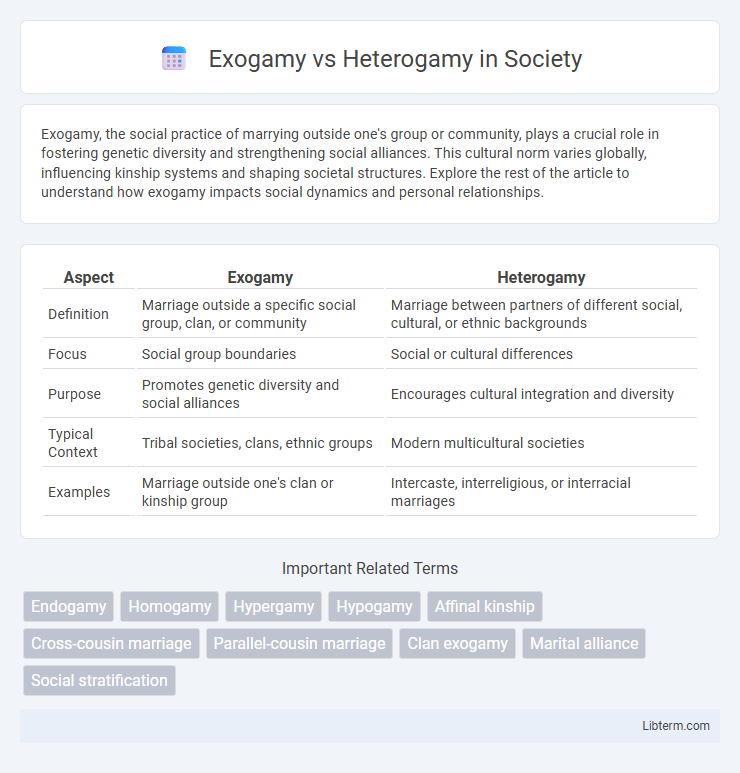Exogamy, the social practice of marrying outside one's group or community, plays a crucial role in fostering genetic diversity and strengthening social alliances. This cultural norm varies globally, influencing kinship systems and shaping societal structures. Explore the rest of the article to understand how exogamy impacts social dynamics and personal relationships.
Table of Comparison
| Aspect | Exogamy | Heterogamy |
|---|---|---|
| Definition | Marriage outside a specific social group, clan, or community | Marriage between partners of different social, cultural, or ethnic backgrounds |
| Focus | Social group boundaries | Social or cultural differences |
| Purpose | Promotes genetic diversity and social alliances | Encourages cultural integration and diversity |
| Typical Context | Tribal societies, clans, ethnic groups | Modern multicultural societies |
| Examples | Marriage outside one's clan or kinship group | Intercaste, interreligious, or interracial marriages |
Introduction to Exogamy and Heterogamy
Exogamy refers to the social practice of marrying outside one's specific social group, clan, or community to promote genetic diversity and social alliances. Heterogamy involves unions between individuals with differing characteristics, such as age, caste, religion, or socio-economic status, emphasizing diversity in partner selection. Both concepts highlight the importance of external partnerships in social and genetic dynamics.
Defining Exogamy: Meaning and Examples
Exogamy refers to the social practice of marrying outside one's specific social group, clan, or tribe to promote genetic diversity and social alliances. For example, in many indigenous communities, exogamy is mandatory to avoid inbreeding and strengthen relationships between different clans. This contrasts with heterogamy, which emphasizes marriage between individuals of different social, ethnic, or cultural backgrounds, often highlighting diversity in traits such as caste, religion, or socioeconomic status.
Understanding Heterogamy: A Clear Overview
Heterogamy refers to marriage or union between individuals who differ significantly in social characteristics such as age, ethnicity, religion, or socioeconomic status. This concept contrasts with homogamy, where partners share similar traits, and it emphasizes how diverse backgrounds influence relationship dynamics and societal integration. Understanding heterogamy provides insights into cultural diversity, social mobility, and the challenges and benefits of pairing across distinct social categories.
Key Differences Between Exogamy and Heterogamy
Exogamy refers to the social practice of marrying outside a specific group, clan, or community to promote genetic diversity and social alliances, while heterogamy specifically denotes marriage between individuals differing in significant traits such as social status, caste, or ethnicity. Exogamy emphasizes the rule of external marital selection, whereas heterogamy highlights differences in characteristics like religion, race, or class within the union. Understanding these distinctions clarifies their roles in shaping social structure and cultural integration.
Cultural and Social Roles of Exogamy
Exogamy, the practice of marrying outside one's social group or community, plays a crucial role in fostering cultural exchange and social cohesion by linking diverse groups through kinship ties. It helps break down clan boundaries, encouraging genetic diversity and mitigating social conflicts while reinforcing alliances and cooperative networks. In contrast, heterogamy emphasizes marriage between individuals of different socioeconomic or cultural backgrounds, which may complement but is distinct from the broader social integrative functions of exogamy.
Heterogamy in Modern Societies
Heterogamy in modern societies reflects the increasing prevalence of marriages between partners differing in social characteristics such as age, ethnicity, religion, or socioeconomic status. This trend challenges traditional norms of homogamy, promoting greater social integration and diversity within family structures. Research shows that heterogamous unions contribute to cultural exchange and adaptability, influencing evolving social dynamics in contemporary populations.
Advantages and Disadvantages of Exogamy
Exogamy promotes genetic diversity by encouraging marriage outside a specific social group, reducing the risk of hereditary diseases and fostering broader social alliances. It can strengthen communal ties and enhance cultural exchange but may also lead to social stigmatization or conflicts due to differences in customs, traditions, or beliefs. Challenges include potential difficulties in integration and maintaining familial harmony when partners come from diverse backgrounds.
Social Implications of Heterogamous Relationships
Heterogamous relationships, characterized by partners differing in attributes such as age, ethnicity, religion, or socioeconomic status, often challenge traditional social norms and promote cultural diversity. These unions can lead to broader social integration and increased tolerance, yet may also encounter prejudice, family resistance, or legal complications depending on societal context. The social implications of heterogamy include disrupting established social hierarchies and facilitating social mobility through diverse network connections.
Contemporary Trends: Exogamy vs. Heterogamy
Contemporary trends in exogamy reveal a growing acceptance of marrying outside traditional social, ethnic, or cultural groups, driven by increased globalization and multiculturalism. Heterogamy, defined by unions between partners differing in socioeconomic status, education, or religion, reflects changing societal values towards diversity and equality within relationships. Recent studies indicate that both exogamous and heterogamous marriages are becoming more common, challenging historical norms and reshaping modern family dynamics.
Conclusion: Significance in Today’s Society
Exogamy and heterogamy play crucial roles in promoting social diversity and cohesion by encouraging relationships beyond familiar social or genetic boundaries. Exogamy fosters cultural exchange and genetic variability by mandating unions outside one's immediate group, while heterogamy emphasizes relationships between individuals with differing social characteristics like class, ethnicity, or religion. Their significance today lies in challenging social norms, enhancing inclusivity, and supporting dynamic, interconnected societies that value both cultural heritage and social integration.
Exogamy Infographic

 libterm.com
libterm.com